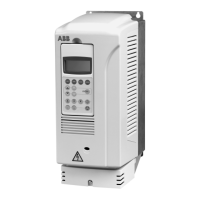Technical data 109
Derating
The load capacity (current and power) decreases if the installation site altitude
exceeds 1000 meters (3300 ft), or if the ambient temperature exceeds 40 °C (104 °F).
Temperature derating
In the temperature range +40 °C (+104 °F) to +50 °C (+122 °F) the rated output
current is decreased 1% for every additional 1 °C (1.8 °F). The output current is
calculated by multiplying the current given in the rating table by the derating factor.
Example
If the ambient temperature is 50 °C (+122 °F), the derating factor is 100% -
1 · 10 °C = 90% or 0.90. The output current is then 0.90 ·
I
2N
or 0.90 ·
I
2hd
.
Altitude derating
In altitudes from 1000 to 4000 m (3300 to 13123 ft) above sea level, the derating is
1% for every 100 m (328 ft). For a more accurate derating, use the DriveSize PC tool.
See
Installation sites above 2000 metres (6562 feet)
(page 57).
Fuses
gG and aR fuses for protection against short circuits in the input power cable or
drive are listed below. Either fuse type can be used if it operates rapidly enough.
Frame sizes R2 to R4
Check from the fuse time-current curve that the operating time of the fuse is
below 0.5 seconds. The operating time depends on the supply network impedance
and the cross-sectional area and length of the supply cable. The short-circuit current
can be calculated as shown below in
Frame sizes R5 and R6
(page 111).
Note 1: See also
Thermal overload and short-circuit protection
(page 44). For UL recognized fuses, see
NEMA data
on page 119.
Note 2: In multi-cable installations, install only one fuse per phase (not one fuse per conductor).
Note 3: Larger fuses than the recommended ones must not be used.
Note 4: Fuses from other manufacturers can be used if they meet the ratings and the melting curve of
the fuse does not exceed the melting curve of the fuse mentioned in the table.

